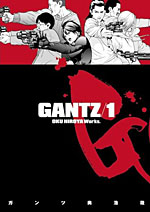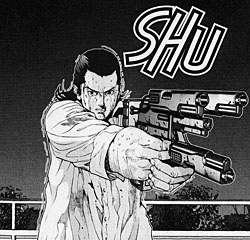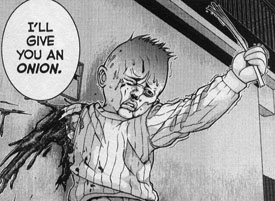 By Hiroya Oku
By Hiroya Oku
224 pages, black and white
Published by Dark Horse
Gantz is the perfect example of a title where I knew nothing about the book going into it, save that it was extremely popular and had spawned an animated version that was fairly huge. After reading the first volume, I thought I had an idea of what Gantz was all about and what future volumes would show. And then I sat down and read the second volume—and suddenly I wasn’t so sure about anything that has to do with Gantz.
Kei and Masaru are both high school students, waiting for the subway to arrive when a homeless man staggers onto the tracks. Masaru leaps down to rescue him, and before long Kei is shamed into helping. The homeless man lives, but the two are killed by the train—and that’s when things start getting strange. They’re transported to a high-rise apartment with other people who also just died, and a mysterious black sphere in the center of the room that offers them uniforms and weapons. The game, it seems, has just begun. They’re given their first target and a clock. Only things? Aren’t as easy as they seem.
 Reading the first volume of Gantz brings to mind a strange sort of combination of high-stakes action and sexual tension. This is a comic, after all, that has one of the newly dead/alive people teleport in naked and land on top of Kei—who promptly gets turned on by the whole situation. Most of the chapter break illustrations involve that same naked woman in a variety of sultry, barely-clothed poses. Meanwhile, we’re seeing a strange cast of characters all assembled; the defensive, sharp-mouthed girl, the man who thinks they’re all in the afterlife, the two Yakuza thugs, the schoolteacher who takes command, the mysterious student… In other words, it’s the diverse group of characters that are clearly going to serve as our supporting cast. Towards the end of the first volume as they track down the "onion alien" amidst arguments and confusion, I figured we had the status quo firmly set in place for the entire series.
Reading the first volume of Gantz brings to mind a strange sort of combination of high-stakes action and sexual tension. This is a comic, after all, that has one of the newly dead/alive people teleport in naked and land on top of Kei—who promptly gets turned on by the whole situation. Most of the chapter break illustrations involve that same naked woman in a variety of sultry, barely-clothed poses. Meanwhile, we’re seeing a strange cast of characters all assembled; the defensive, sharp-mouthed girl, the man who thinks they’re all in the afterlife, the two Yakuza thugs, the schoolteacher who takes command, the mysterious student… In other words, it’s the diverse group of characters that are clearly going to serve as our supporting cast. Towards the end of the first volume as they track down the "onion alien" amidst arguments and confusion, I figured we had the status quo firmly set in place for the entire series.
With that in mind, it’s to Hiroya Oku’s credit that the book suddenly shifts, with no real warning, into something a little more horrific. Characters die left and right, some characters are hiding secrets from the rest of the characters, and in general nothing is really what it seems. It’s fairly creepy as you start to realize how in over their heads the characters in Gantz really are, and just how much trouble they’re in. I actually felt a little uneasy during some of the early chapters of Volume 2; as the massacre continues it’s hard to not forget the black sphere’s words in the first volume, "All of your old lives are gone. I will decide how to use your new lives." And from there, things just get worse. The revelations about the "game" they’re playing at the end of the second book are rather creepy, and it’s hard to help but wonder how many of our surviving characters will make it through the next attack. In other words, Gantz is not at all what it seems, and in a good way.
 The end of the first volume shows how Oku draws Gantz; starting with computer models of figures (looking like mannequins) that he then draws on top of, with computer-rendered backgrounds by his assistants. The end result is amazingly consistent. There’s no worry about losing a character’s body shape or having them appear out of proportion. At the same time, because they’re just used as models (instead of the characters themselves being drawn entirely on the computer) they still feel very organic and fresh, not like the stiff-and-posed look that so many computer-created characters in comics look like. And, if nothing else, Oku can certainly draw violence and gore quite well; there are several scenes with actually made my stomach jump a little bit by way of reaction.
The end of the first volume shows how Oku draws Gantz; starting with computer models of figures (looking like mannequins) that he then draws on top of, with computer-rendered backgrounds by his assistants. The end result is amazingly consistent. There’s no worry about losing a character’s body shape or having them appear out of proportion. At the same time, because they’re just used as models (instead of the characters themselves being drawn entirely on the computer) they still feel very organic and fresh, not like the stiff-and-posed look that so many computer-created characters in comics look like. And, if nothing else, Oku can certainly draw violence and gore quite well; there are several scenes with actually made my stomach jump a little bit by way of reaction.
Gantz is certainly not for the faint of heart. It’s shocking in quite a few places, and alternates between juvenile titillation and hardcore violence and explosive gore. And yet? I can’t deny that I can see how Gantz appeals. There’s that question of the unknown forever hovering over the story after I’ve read the second volume, and just enough twists in the first two books alone that I’m wanting to know more. (The second volume’s cliffhanger is psychologically pure evil, and I applaud Oku for thinking it up.) If you can handle the graphic fight scenes, I’d say you should definitely take a gander.
Purchase Links (Vol. 1):
